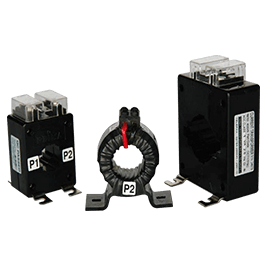A current transformer is defined as "as an instrument transformer in which the secondary current is substantially proportional to the primary current (under normal conditions of operation) and differs in phase from it by an angle which is approximately zero for an appropriate direction of the connections." This highlights the accuracy requirement of the current transformer but also important is the isolating function, which means no matter what the system voltage the secondary circuit need be insulated only for a low voltage.
The current transformer works on the principle of variable flux. In the "ideal" current transformer, secondary current would be exactly equal (when multiplied by the turns ratio) and opposite to the primary current. But, as in the voltage transformer, some of the primary current or the primary ampere-turns is utilized for magnetizing the core, thus leaving less than the actual primary ampere turns to be "transformed" into the secondary ampere-turns. This naturally introduces an error in the transformation. The error is classified into two-the current or ratio error and the phase error.
